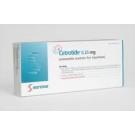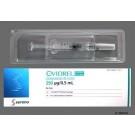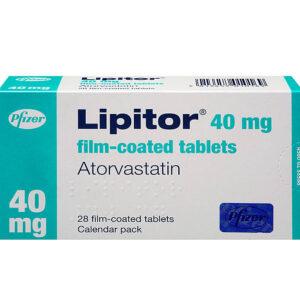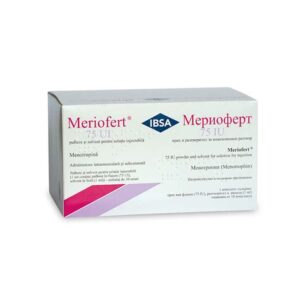What is the most important information I should know about Cetrotide?
Do not use Cetrotide if you are pregnant. Cetrotide is in the FDA pregnancy category X. This means that Cetrotide is known to cause birth defects.
Talk to your doctor before using cetrorelix if you have kidney disease or any renal (kidney) problems. Cetrorelix should not be used in patients with severe renal impairment.
WHAT SHOULD I DISCUSS WITH MY HEALTHCARE PROVIDER BEFORE USING CETROTIDE?
Do not use cetrorelix without first talking to your doctor if you have ever had an allergic reaction to gonadotropin-releasing hormone (Lupron, Antagon, Goserelin, Nafarelin, Synarel, Zoladex), mannitol, or a medicine similar to Cetrotide. Do not use cetrorelix if you are pregnant.
Cetrorelix is in the FDA pregnancy category X. This means that cetrorelix is known to cause birth defects. It is not known whether cetrorelix passes into breast milk. Do not use cetrorelix without first talking to your doctor if you are breastfeeding a baby.
Talk to your doctor before using Cetrotide if you have kidney disease or any renal (kidney) problems. Cetrorelix should not be used in patients with severe renal impairment.
HOW SHOULD I USE CETROTIDE?
Use cetrorelix exactly as directed by your doctor. If you do not understand these directions, ask your doctor, nurse, or pharmacist to explain them to you.
Cetrotide is intended for subcutaneous (under the skin) administration. If you are administering this medication at home, your doctor will give you detailed instructions on how to mix the solution and administer the injection. Do not inject cetrorelix if you are not sure how.
Cetrotide for IVF may be prescribed for use as a single dose (3 mg), or use once a day (0.25 mg). Your doctor will determine which treatment regimen is best for you. Follow your doctor’s instructions.
Wash your hands well with soap and water before preparing and administering this medication.
To prepare the injection:
- On a clean surface, lay out everything that you need. Flip off the plastic cover of the vial. Wipe the aluminum ring and the rubber stopper with an alcohol wipe. Take the injection needle with the yellow mark and remove the wrapping. Take the pre-filled syringe (filled with sterile water for injection) and remove the cover. Put the needle on the pre-filled syringe and remove the cover. Push the needle through the center of the rubber stopper of the vial. Inject the water into the vial by slowly pushing the plunger of the syringe. Leave the syringe on the vial. Gently shake the Cetrotide vial until the solution is clear and without residue. Avoid forming bubbles during dissolution.
- Withdraw the entire contents of the vial into the syringe. If the liquid is left in the vial, invert the vial, pull back the needle until the opening of the needle is just inside the stopper. If you look from the side through the gap in the stopper, you can control the movement of the needle and the liquid. It is important to withdraw the entire contents of the Cetrotide vial. Detach the syringe from the needle and lay down the syringe.
- Take the injection needle with the grey mark and remove its wrapping. Put the needle on the syringe and remove the cover of the needle. Invert the syringe and push the plunger until all air bubbles have been pushed out. Do not touch the needle or allow the needle to touch any surface.
To administer the injection:
- Choose an injection site at the lower abdominal wall, preferably around the belly button. If you are on a multiple-dose (0.25 mg) regimen, choose a different injection site each day to minimize local irritation. Take the second alcohol wipe and clean the skin at the injection site. Inject the prescribed dose as directed by your doctor or healthcare provider.
Use the solution immediately after it is mixed. Throw away any medicine that is left over.
Never reuse a needle or syringe. Dispose of all needles and syringes in an appropriate, puncture-resistant disposal container.
Store the 3 mg Cetrotide product at room temperature, away from direct light, moisture, and heat. Keep the packaged tray in the outer carton to protect it from light. Store the 0.25 mg Cetrotide product in the refrigerator in the original outer carton, to protect it from light and moisture.
WHAT HAPPENS IF I MISS A DOSE?
Contact your doctor if you miss a dose of Cetrotide for IVF. Do not use a double dose of this medication without first talking to your doctor.
WHAT HAPPENS IF I OVERDOSE?
An overdose of Cetrotide is unlikely to threaten life. If an overdose of cetrorelix is suspected, notify your doctor immediately to check whether an adjustment of the further ovarian stimulation procedure is required. If you cannot contact your doctor, call an emergency room or poison control center for advice.
WHAT SHOULD I AVOID WHILE USING CETROTIDE?
There are no restrictions on food, beverages, or activity during therapy with cetrorelix unless otherwise directed by your doctor.
CETROTIDE SIDE EFFECTS
Stop using Cetrotide and seek emergency medical attention if you experience an allergic reaction (difficulty breathing; closing of your throat; swelling of your lips, tongue, or face; or hives).
Approximately 3.5 % of female patients treated with cetrorelix have developed ovarian hyperstimulation syndrome (OHSS). Symptoms of OHSS include severe pelvic pain, swelling of the hands or legs, abdominal pain and swelling, shortness of breath, weight gain, low urine output, diarrhea, and nausea or vomiting. OHSS can be fatal. Notify your doctor immediately or seek emergency medical attention if you develop any of these symptoms.
Other side effects may also occur. Notify your doctor if you experience
- nausea;
- headache; or
- redness, bruising, itching, or swelling at the injection site.





